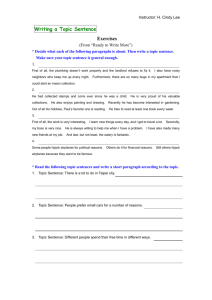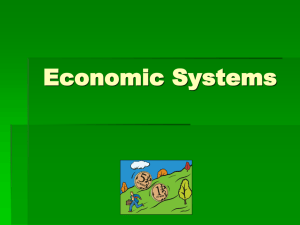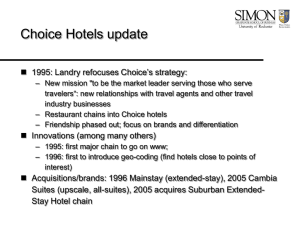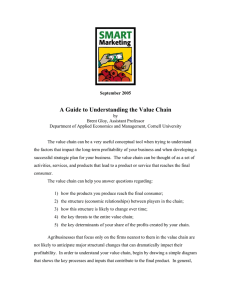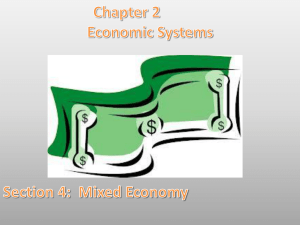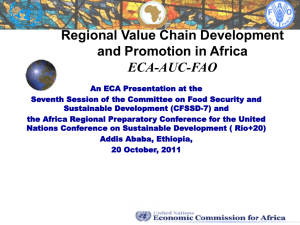Click here for Chapter 2/Section 1 Economics
advertisement
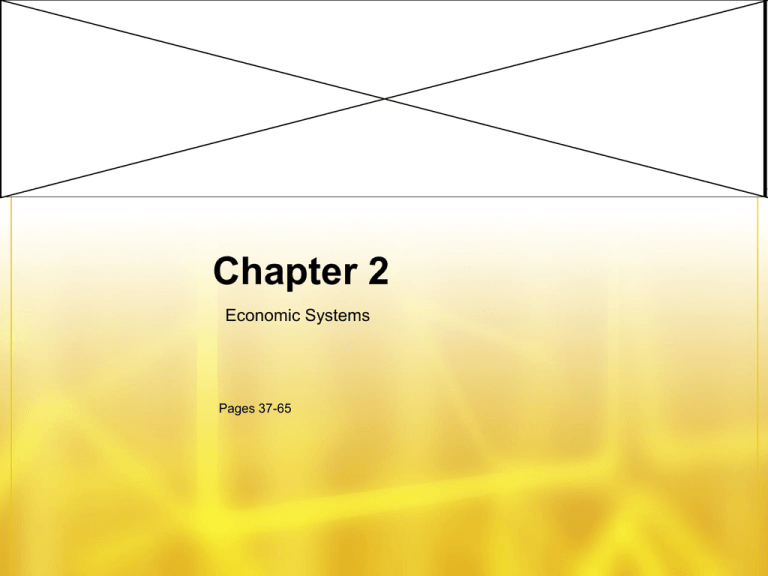
Chapter 2 Economic Systems Pages 37-65 Classroom Economics • The classroom will become an economy that produces threecolor paper chains made with four-inch strips and paper airplanes with drawn-on windows and a logo on the wings. • You will be divided into five groups. Command Economy • Groups must get supplies from the teacher. • Group 1 measures and marks the paper for cutting. • Group 2 cuts each strip. • Group 3 attaches strips to make three-color chains. • Group 4 folds the paper airplanes. • Group 5 draws the logos and windows. Free Market Economy • Supplies are available from the teacher, but groups can use their own supplies. Each group decides whether to make chains or airplanes or both. Groups may trade amongst themselves. The group with the most pairs of chains and airplanes wins. Reflection • Compare the total number of chains and airplanes produced under each system. Who owned the factors of production and who made the decisions about what to produce and how to produce it. Section 1 Objectives • Identify the three main types of economic systems • Understand how a traditional economy operates, including its advantages and disadvantages • Analyze how modern forces are changing traditional economies. Types of Economic Systems • How important is it to feel that you have choices in your lives? • Give some examples of the choices that you have available • Consider instances in which your choice was denied and the reasons for the denial. Key Concepts • Utopia means “no place” in Greek, a book written by Thomas More. In the book wants are limited and easily fulfilled. • Again the three questions need to be answered: – What should be produced? – How should it be produced? – For whom will it be produced? Economic Systems • Economic System: society uses its scarce resources to satisfy its people unlimited wants. • “Mixed” economies: which have features of more than one type of economies. Traditional Economy • Traditional Economy: A system which families,clans, or tribes make economic decisions based on customs and beliefs that have been handed down from generation to generation. • Example: Men hunter gatherers, women tended to children and the crops, youngest helped with chores and learned skills needed for the future. Command Economy • Command Economy: government decides on what goods and services will be produced, how they will be produced, and how they will be distributed. • Example: Wants of individual consumers are hardly ever considered.Government usually owns the means of production, all resources and factories. North Korea and Cuba Market Economy • Market Economy: based on individual choice, not government directives. In this system consumers and producers drive the economy. • Consumers: can spend money as they wish, enter into business, or sell their labor. • Producers: decided what goods or services they will offer. Make choices how to use their limited resources to make a profit. Discussion-Questions • Traditional- What-what has always been produced; How-in traditional ways; for whom-good of the group • Command-What-the government decides; how-by governmentowned means of production; for whom-the whole group • Market-What-the goods consumers will buy are produced; how-by individually-owned enterprises; for whom-people who can afford them Activity Understand Types of Economies 1. 2. 3. You will be divided into small groups. In your group create a poster that shows the three economic questions (What should be produced?-How should it be produced?-For whom will it be produced?) and how a traditional, command, and market economy answers each of those questions. Arrange the poster in any way but make sure that it contains at least one illustration for each question. Characteristics of Traditional Economies Advantages • 1. Answers the three economic questions. • 2. Produces what is best to ensure survival. • 3. Distribution determined by custom and tradition • 4. Very little disagreement over economic goals and roles Disadvantages • 1. based on ritual and custom. • 2. resist change • 3. inefficient and does not adapt to change • 4. prevent people from doing the jobs they want to do or best suited • 5. Don’t acquire material wealth • 6. much lower standard of living Under Pressure to Change • Kavango: Tribe of Namibia in southern Africa. • Traditional economies have been under pressure to change. Practice Subsistence farming: grow enough to feed their own families. Now with modern media they are constantly exposed to outside influences. Many are leaving to go to larger areas. • Some have switched to commercial farming, but many still practice traditional farming.
